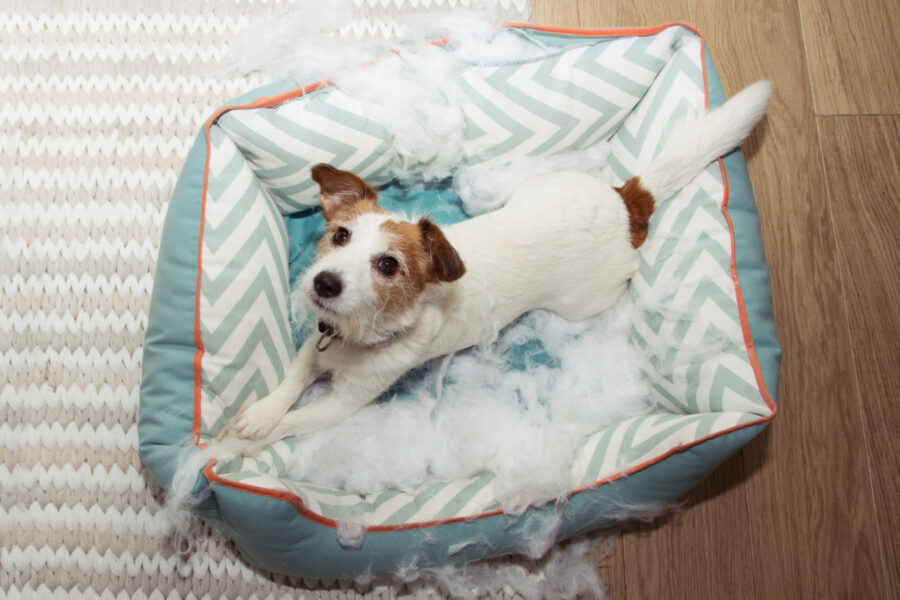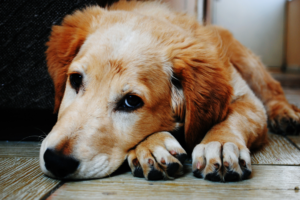Is your dog destroying beds? Dogs destroy beds for a number of reasons. Exploding bed (and couch) photos are quite common on social media and generate laughs, sympathy and shared experiences. However, the reality for dogs that repeatedly destroy beds (or couches) is no laughing matter. It gets expensive and could lead to health problems too.
But there are things we can do to reduce the likelihood of dogs destroying beds, couches and cushions. I’ll talk about these strategies in this blog as well as reasons dogs destroy beds.
Reasons why dogs destroy beds
Sleeping behaviour
Have you ever watched a dog paw at blankets or the ground and then circle around a few times before curling up to rest? What about dogs that dig a depression in the ground and then flop their backsides into the depression with their heads resting on the higher ground?
These are natural resting/sleeping related behaviours in dogs.

I have several theories of why dogs do this but for the case of the dog that destroys their bed the import part to notice is the digging behaviour.
When dogs dig on their beds, they may damage the material creating a very tempting hole for the dog to expand or chew on. This leads to the ultimate destruction of the bed.
Especially for young and energetic dogs it’s really important to choose a bed that is made of strong material and ideally a soft soother type of bed. These beds form a depression when a dog lays in them.
This combination seems to reduce the likelihood of that bed being destroyed in my household over the years. I have a few soggy dog beds that have lasted 5 dogs. The huskies and kelpies in my life have all enjoyed sleeping on them.
Other people have had success with canvas beds. Ripstop canvas in particular is quite tough.
Chewing behaviour
Dog’s chew, pluck and shred items. Chewing can help xyz. Dogs also find protrusions interesting to nibble on. Have you noticed how many dogs tend to work at removing a toys ear or arm or other lumpy bit? Or the time they take to remove the fluff from a tennis ball (not recommended for a few reasons)? Or how they chew on edges of things? Or if a tooth punctures a toy the dog will then focus on that hole and increase it?
When we take these tendencies into consideration, we can see that some dog beds must be very tempting for dogs to chew, pluck or shred.
For example, beds with piping, zips in obvious places, fabric ties, fancy trim, obvious seams, buttons etc are often the target of a dog’s teeth.
Choosing beds made of single material, without zippers on the edge of the bed, without piping and less obvious seams may draw a dog’s attention less than other beds.
Remember though to keep in mind the digging behaviour in dogs covered in the first point.
Separation anxiety/isolation destress/separation related problems/barrier frustration
Some dogs are crated as they suffer with separation anxiety and were damaging the home when left alone. These dogs may be digging at the crate door trying to escape leading to a destroyed bed in the crate. This digging is not part of the nesting/sleeping preparation behaviour of dogs and is instead a desperate attempt to escape the crate and find their human(s).
Dogs that have been crated or are placed behind a barrier may become frustrated that their movement is restricted or that they can’t reach you. These dogs may start to dig and scratch at the crate door as well, also in an attempt to escape.
The solution here is to focus on the underlying reason for the destroyed bed. Please seek qualified and experienced behavioural help for these dogs. You can contact me for tips on finding someone to help your canine friend.
While carefully selecting a bed design can reduce the chance of a dog destroying their beds it doesn’t eliminate the risk, especially with young dogs.
But there are some other things we can do to help end the destroyed bed saga.
Other prevention tips for the dog destroying beds
Praise dogs
Praise dogs for resting quietly on their beds and interrupt their behaviour if you notice them starting to chew on their bed.
I tend to leave the room and have a drink of water, me leaving the room tends to stop a dog as they follow me to the kitchen. We can then settle down again and I can praise the dog for resting quietly on their bed. If I think it is time that my dogs would be more active, I might give them a long-lasting chew to last them until I’m ready for their late afternoon activities.
Physical and mental exercise
Ensure a dog has had adequate physical and mental exercise/activities in the morning before being left unsupervised and in the later afternoon/evening. If your dog is very active and highly energetic have a read of some extra tips in this blog post ‘top 3 tips for living with high energy dogs‘
Enrichment
Provide alternative attractive things for your dog to chew on and shred.
For dogs that really seem to enjoy pulling the stuffing out of beds (or toys, couches, cushions etc) here are some additional environmental enrichment activities you could add to your canine friend’s day.
Giving dogs alternative acceptable outlets for their destuffing desires can be helpful as part of a behaviour modification strategy, especially when combined with training and management.
Shredding things is a normal behaviour for dogs; however, it can be a very expensive activity when they direct their attention to our furniture and their beds.
Here are alternative activities your canine friend can participate in that gives them an outlet for their shredding behaviour.
5 enrichment activities for dogs that enjoy removing stuffing
Please supervise your canine friend while they are using these items and stop the activity if they look like they will eat non-food items. Ensure you are satisfied the activities are safe for the dog(s) in your care and acknowledge that enrichment is not risk free. To find out more about the risks have a conversation with your veterinarian and make an informed decision. What may be suitable for one dog may not be safe for another.
Some dogs will enjoy destuffing these enrichment activities, others may use different techniques. Either way most dogs will enjoy these supervised games.
Stuffed Hol-ee (or similar) ball
What you need
- Hol-ee ball (this is a hol-ee ball)
- Treats
- Strips of paper/material/lettuce leaves etc
How to prepare
- Wrap treat in the wrap of your choice
- Push wrapped treat into the ball
Pass the parcel
What you need
- Treats
- Paper
How to prepare
- Lay out one sheet of paper
- Place a treat on the paper
- Ball up the paper around the treat
- Lay out another sheet of paper
- Place a treat on that sheet of paper
- Place the treat and paper you just balled up on that flat sheet of paper
- Wrap that first ball up
- Repeat many times
Tissue box
What you need
- Empty tissue box
- Paper/lettuce leaves/zucchini peel/carrot/material etc
How to prepare:
- Place strips of paper/vegetables etc in the tissue box
- Occasionally put in a treat between strips as you fill up the box
Stuffed vegetables
What you need:
- Lettuce (like cos, loose headed lettuce), celery, cabbage
- Treats
How to prepare:
- Place treats between the whole vegetable layers
Stuffed paper roll
What you need:
- Paper towel roll or toilet paper roll (or similar)
- Strips of paper/material/zucchini/carrot etc
- Treats
How to prepare:
- Wrap treats in the strips of your choice
- Place wrapped treats into the roll
What part of this post helped you the most? I’d love to know so please leave a comment below.




